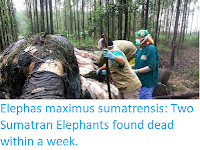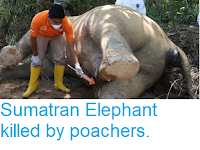An Elephant has died after consuming a Pineapple filled with explosives in Kerala State, India. The incident happened on 23 May 2020 in village near the Silent Valley National Park in Palakkad District, when the Animal is believed to have consumed a 'Pig Cracker', a fruit filled with explosives used to deter Wild Pig, which are a serious agricultural pest, something widely used in India and Sri Lanka. The Elephant, a fifteen-year-old female that was pregnant at the time, is reported to have received severe injuries to the mouth and face, and despite attempts by local wildlife officials and vets to provide treatment, died on 27 May while standing in a river near the village, apparently in an attempt to relieve the pain of the injury.
A fifteen-year-old female Elephant that died in a river in Palakkad District, Kerala, on 27 May 2020, several days after eating a Pineapple laced with explosives. AFP.
The incident has prompted widespread outrage in India, with many leading politicians and celebrities calling for those responsible to be brought to justice. The incident is being investigated by the Indian Forest Service, with several people having been arrested and interrogated. This situation has been made more complex by a rumour that the death happened in Malappuram District, to the west of Palakkad, which has a largely Muslim population, something which some politicians appear to be using to fuel sectarian differences across India.
An Indian Elephant injured by explosives hidden within a Pineapple in Kerala State stood in a river near where the incident happened for four days before dying, apparently in an attempt to alleviate the pain of the injury. Mohan Krishnan/Indian Forest Service.
The population of India has risen from 376 million in 1950 to 1339
million today, fuelling an expansion of both urban and agricultural land
use into former wilderness areas. The wild Elephant population has declined over the same period, but still stands at about 27 000. Many
animals will simply flee such incursions, or, if unable to, are likely
to end up in the cooking pots of hungry villagers. Elephants, however,
are a somewhat different proposition. They are large animals, not used
to being challenged by other animals in their home ranges, and typically
live in matriarchal herds of up to a hundred, with herds holding large
territories, criss-crossed by Elephant trails. A herd of Elephants
encountering a new Human settlement, particularly a poorly defended structure, are unlikely to attempt to go round it, and
are quite likely to maximise the damage they cause to show their
displeasure. This has resulted in an increasing cycle of Elephant-Human conflict in rural areas of India, with 2361 people killed by Elephants between 2014 and 2019, while in the same period 510 Elephants were killed by people.
See also...
Follow Sciency Thoughts on Facebook.








